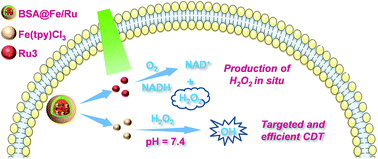A targeted and efficient CDT system with photocatalytic supplement of H2O2 and hydroxyl radical production at a neutral pH†
Abstract
The bottleneck problems of chemodynamic therapy (CDT) are the dependence on an acidic pH (2.0–4.0), insufficient H2O2 level in tumor tissues, and potential systematic toxicity of inorganic nanomaterials-based CDT agents. In this study, the new tricks of two old compounds, i.e. [Ru(phen)2(PIP-OCH3)](PF6)2 (Ru3, phen = 1,10-phenanthroline, PIP-OCH3 = 2-(4-methoxy phenyl)-1H-imidazo[4,5-f][1,10]phenanthroline) and Fe(tpy)Cl3 (tpy = 2,2′:6′,2′-terpyridine), were harnessed to construct an ideal CDT system. Ru3 was able to efficiently photo-catalyze NADH oxidation accompanied by the production of H2O2in situ with a high yield of 73.2%, which can be converted into cytotoxic hydroxyl radicals by the biocompatible Fe(tpy)Cl3 at a neutral pH. By loading both Ru3 and Fe(tpy)Cl3 in tumor-targeting bovine serum albumin (BSA), the obtained BSA@Fe/Ru nanoparticles exhibited a highly efficient, selective, and photo-controlled CDT activity both in vitro and in vivo. This work may provide new sights for overcoming the issues confronted in CDT.



 Please wait while we load your content...
Please wait while we load your content...